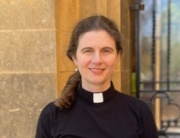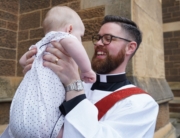A Sermon by The Rev’d Canon Jenny Wilson

In the name of God, creating, redeeming, sanctifying… Amen.
The photo in our Evensong booklets was taken by John Hamilton, one Friday morning after the early service in the Lady Chapel, after the congregation had had its breakfast together. There was a puddle in the Cathedral car park and, in the puddle, a reflection of the cathedral. And autumn leaves were dotted around the puddle, adding colour to the grey of the asphalt and of the cathedral stone. And that was what John took his photo of. The Cathedral’s reflection in the puddle, the autumn leaves scattered around.
And I wondered about that. About the greyness of things and what light does. Light reflecting the truth of a building that points to the most profound truth. You can see the spires of the cathedral in the reflection in the puddle. The spires pointing to the heavens are reflected in the grey puddle so bounded on the earth. The building pointing to the truth of God, God who creates all things, God who redeems all things too. And the building that speaks of these things. Speaks to all of us who enter its doors. To all of us who call it home, to all who enter on occasion, and to all who walk through the doors for the very first time.
The former dean of Westminster Abbey, Michael Mayne, wrote this about the Abbey he served:
“I never fail to be moved by how affected [visitors] are by the atmosphere in this historic, holy and storied space. Although I use words with which to tell its story, it is invariably the space that speaks.” [1]
For us, too, it is often the space that speaks. On this, our Patronal Festival, on the feast day for our patron Saint Peter, we might think about the building and what it means to us and what it means to God. And we might think about Peter.
The grey puddle might be a symbol of Peter in a way. He is so flawed. Always impetuous. Always blundering things. So often, dominated by fear rather than the love he so longs to express. Rushing out on the sea to be with Jesus after he had calmed a storm, and then looking down in terror at the waves and sinking …until Jesus grabs his hands, saying “Oh ye of little faith.” Rushing to name him “Messiah” at Caesarea Philippi when Jesus asks that question “Who do you say that I am?” And then panicking when Jesus tells him what “Messiah” means, about death, about rising again. And about Peter saying, “No, that cannot be so.” And Jesus sternly rebuking him. And, then, in the saddest story of all, Peter denying Jesus three times after he had told him he would go to his death for him. Only, when the time came, the fear overwhelmed him. And the cock crowed. And what does the crow of the cock do? It heralds the dawn, the coming of the light. The coming of Peter’s realisation who Jesus is and he, Peter, how flawed he is. Grey in character like the asphalt in the photo where the puddle is.
And yet, how is it that Jesus shines light in our dark places, … Jesus says to Peter, in Matthew’s Gospel, anyway, “You are Peter, and, on this rock, I will build my church.” As if flaws are not a problem for Jesus. As if he knows that the church will be built of ones such as Peter, ones such as us, too. As if puddles might reflect the glory of God.
Once a year, the Anglican Schools come to our Cathedral for a morning. The students go in groups to different parts of the Cathedral, learning hymns and prayers for the worship that will conclude their time here. But, I have the best role, I think! I take my groups up to the gallery of the Cathedral, to “the God View” one dean once called it, and there we look and we see in what ways the space speaks to us. Speaks to us of God. I tell them that our faith, put simply, says two things really. Just two things. Two things are reflected into that grey puddle in the spires of stone, with the golden autumn leaves around.
God who made us, loves us and, when we make a mistake, God forgives us.
That’s it really. It’s there, writ large in Peter’s story and it’s there in our own. It’s written in the story of individuals and communities, of nations and of the whole earth. And of humanity’s relationship with the earth.
God who made us, loves us and, when we make a mistake, God forgives us.
So, we look at the building from our God View in the Gallery and we wonder about the different ways in which it speaks this truth. We think about the ways in which different people encounter truth, some through looking, some through listening, some through words, spoken and reflected upon, some, actually, in silence.
The space speaks through its very architecture, spires reaching to the heavens and the height of it; some of the students smile in wonder at the height of it, when they gaze from the Gallery at the nave floor below. The space speaks almost of the “size” of God, the mystery of God, the “beyondness” of God. The space speaks through the windows and the reredos, telling the stories of the characters of our faith … Peter, of course, and angels, and bishops, and the crucifixion in all its horror in the window named “the love of God” window, and then images of our land in the clerestory windows above the nave. It is an incarnation we are talking about, in our Cathedral. God is born in specific times and specific places. So, how wise of Cedar Prest to create in stained glass, images of the God story set in our country, our culture.
The space speaks through the places for prayer and sacrament and music. The places where prayers have been said for the Cathedral’s over 150 years. The Lady Chapel where tears have been shed as people prayed alone and Eucharists have been celebrated every weekday morning, pretty well, for those who sometimes bleary eyed have made the journey there at the start of day. The nave where we have gathered in large numbers to welcome and farewell, to grieve and celebrate, to baptise, and wed, and at a funeral to commit a loved one’s body, ashes to ashes dust to dust, into the great love of God.
And the choir stalls, designed in memory of the chancels in monasteries and nunneries where hour by hour almost those devoted to the religious life sung antiphonally, across to one another. The choir stalls are home to the glorious music of our Cathedral, singing the truth of God and the truth of living as the flawed created beings that we are.
Yes, as Michael Mayne said, although [we] use words with which to tell [our]story, it is invariably the space that speaks.
Jesus says to Peter, in Matthew’s Gospel, “You are Peter and on this rock I will build my church.” For flaws are not a problem for Jesus. As if he knows that the church will be built of ones such as Peter, ones such as us, too.
As if in a grey puddle, on an early winter morning, we might see reflected the spires of a cathedral, our cathedral, this building that points to the most profound truth. Our cathedral whose very being is committed to speaking about the love of God who we know in Jesus, the forgiveness of God spoken to Peter by the charcoal fire after they caught fish for breakfast in the lake, the ever presence of God breathing life and healing into all creation.
[1] Michael Mayne Love, Pray, Remember p 52.





